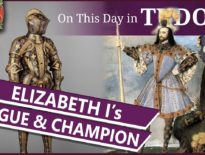On this day in Tudor history, 31st December 1535, in the reign of Henry VIII, Sir William Skeffington, Lord Deputy of Ireland, died at Kilmainham in Dublin.
Skeffington had become known as "the Gunner" following his use of heavy artillery while taking Maynooth Castle in County Kildare, where he killed, or had executed, the whole garrison.
Find out more about the life and career of Sir William Skeffington in today's talk.
Also on this day in Tudor history, 31st December 1559, Owen Oglethorpe, Bishop of Carlisle, died while under house arrest in London.
Oglethorpe is known for officiating at Queen Elizabeth I's coronation in 1559, but also for infuriating the queen at Christmas 1558 by disobeying her instructions at Mass. What did Oglethorpe do?
Find out about Owen Oglethorpe's life and career, and how he upset the queen and ended his days under house arrest, in last year’s video:
Also on this day in history:
- 1564 – Death of Edward North, 1st Baron North, administrator, at the London Charterhouse, which he had acquired in 1545. North served Henry VIII as Treasurer of the Court of Augmentations, Chancellor of the reformed Court of Augmentations and executor of his will. In Edward VI's reign, he was a Privy Councillor but lost this position in Mary I's reign. His Charterhouse was used as lodgings for Elizabeth I and her court for a few days following her accession, and she appointed him Lord Lieutenant of Cambridgeshire. North was buried at Kirtling, in the family vault.
- 1600 – The East India Company, or “Company of Merchants of London trading into the East Indies”, was chartered, i.e. given royal approval, by Queen Elizabeth I.
Transcript:
On this day in Tudor history, 31st December 1535, Lord Deputy of Ireland, Sir William Skeffington, died at Kilmainham in Dublin. He was buried at St Patrick's Cathedral in the city.
His nickname, “the Gunner”, came from his use of heavy artillery while taking Maynooth Castle in County Kildare. He killed, or had executed, the whole garrison there.
Let me give you a few more facts about the Gunner…
• Sir William Skeffington was the eldest son of Thomas and Mary Skeffington, and was born at Skeffington Hall, in Leicestershire.
• He was knighted in Henry VII’s reign and in 1509 served as sheriff for Warwickshire and Leicestershire, and Justice of the Peace for Leicestershire.
• In 1510, following the accession of King Henry VIII, he was issued a royal pardon and served on the commission of the peace in Leicestershire.
• In 1515, Skeffington was appointed Master of the Ordnance, a position which he held until 1529. He spent time in the 1520s in the Pale of Calais strengthening the fortifications there.
• In 1520, he accompanied Henry VIII to the Field of Cloth of Gold meeting with Francis I.
• Skeffington was married twice: first to Margaret Digby, daughter of Sir Everard Digby of Tilton, with whom he had a son, Thomas; then to Anne Digby, daughter of Sir John Digby of Kettleby. Their children included a son, Leonard, who grew up to become Lieutenant of the Tower of London.
• In 1529, Skeffington was sent to Ireland to serve under the Lord Lieutenant, Henry VIII’s illgeitimate son, Henry Fitzroy, Duke of Richmond and Somerset. He was appointed Lord Deputy in 1530. His mission was to promote good relations between the earls of Kildare, Ormond, and Desmond, and to negotiate with them to get their help keeping order in Ireland.
• In late 1530, he was successful in subduing Gaelic leaders O’Moore and O’Connor, and in 1531 he and Gerald Fitzgerald, Earl of Kildare, took and destroyed another leader O’Neill’s castle, also destroying neighbouring villages. He also accepted the formal submission of Hugh Duff O'Donnell to Henry VIII in Drogheda. However, relations between Skeffington and Kildare broke down, with each complaining about the other’s actions, and Skeffington ended up encouraging a feud between the Earl of Ossory and Kildare. In May 1532, he was accused of provoking the feud and being biased towards Ossory. Skeffington ended up retiring to England in autumn 1533, but was reappointed as Lord Deputy in May 1534. Kildare was in prison by this point and Kildare’s son, Silken Thomas, had repudiated his allegiance to Henry VIII. Skeffington was, however, aged about 70 by this point, and not in the best of health. He stalled in leaving for Ireland, but eventually set sail in October, taking heavy artillery with him, along with 2,300 men.
• At Drogheda, Skeffington had Silken Thomas proclaimed a traitor. Following his return to Dublin, Skeffington fell ill. In December 1534, John Alen recorded “the deputy is old, and cannot take pains by reason of sickness”. However, after a few months, he recovered temporarily.
• In the spring of 1535, Skeffington burnt villages that supported Kildare and in the March, after the surrender of Kildare’s fortress, Maynooth Castle, following siege and the use of his heavy artillery, he ordered the executions of the entire garrison. His son, Leonard, also served as a soldier with him at this time.
• In July 1535, Skeffington was replaced as military commander by Lord Leonard Grey, but in August 1535, Skeffington was able to report to the king that Silken Thomas and O’Connor had both submitted to him.
• Skeffington fell ill again in late summer 1535 and he died on this day in history, 31st December 1535, at Kilmainham in Dublin. He was buried in Ireland, in St Patrick's Cathedral, Dublin, but a monument to him was erected at Skeffington.
• Skeffington’s eldest son, Thomas, inherited his father’s property, and Lord Leonard Grey succeeded him in Ireland.



Leave a Reply